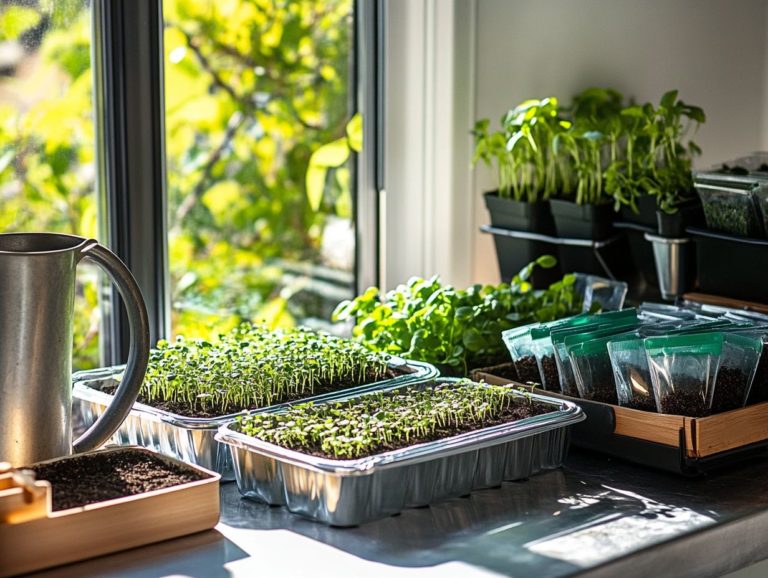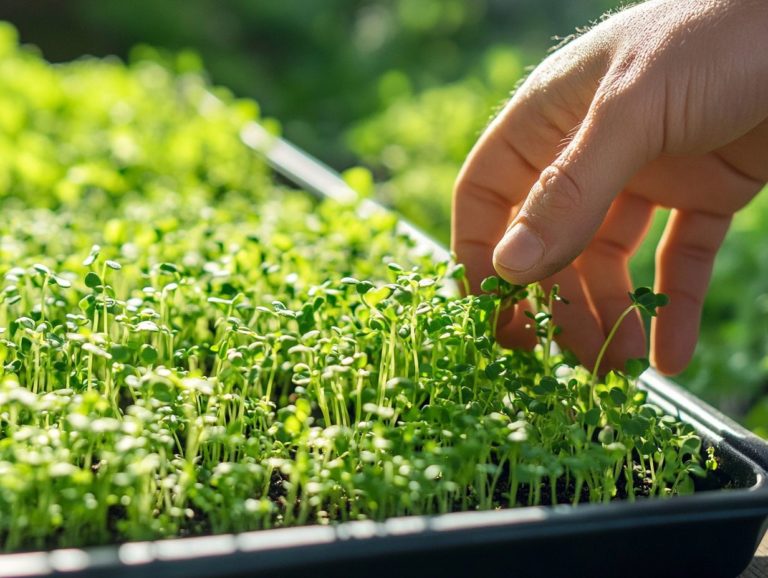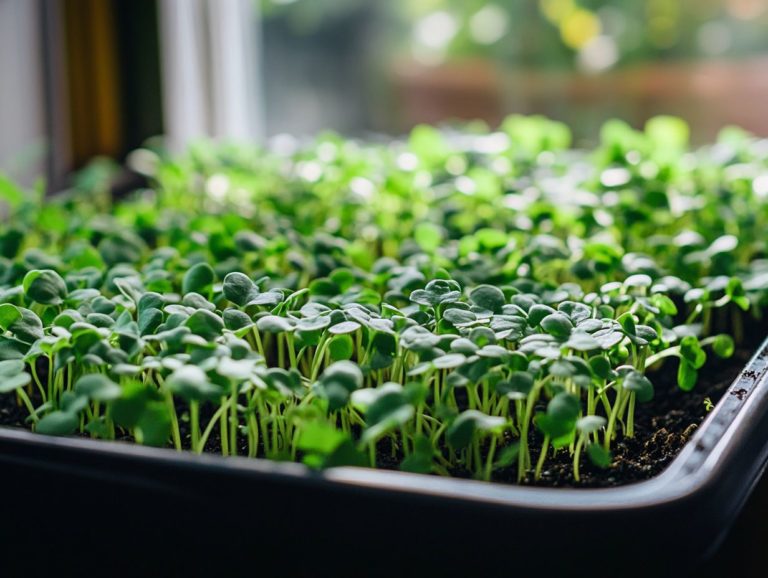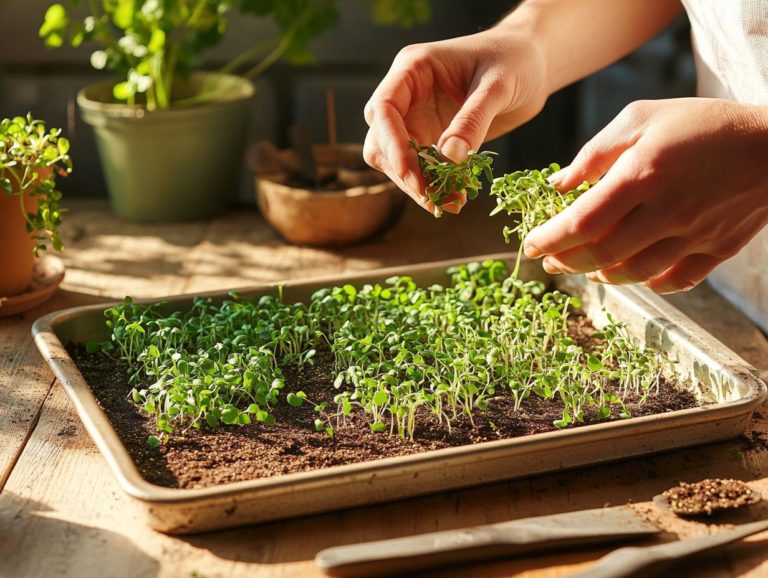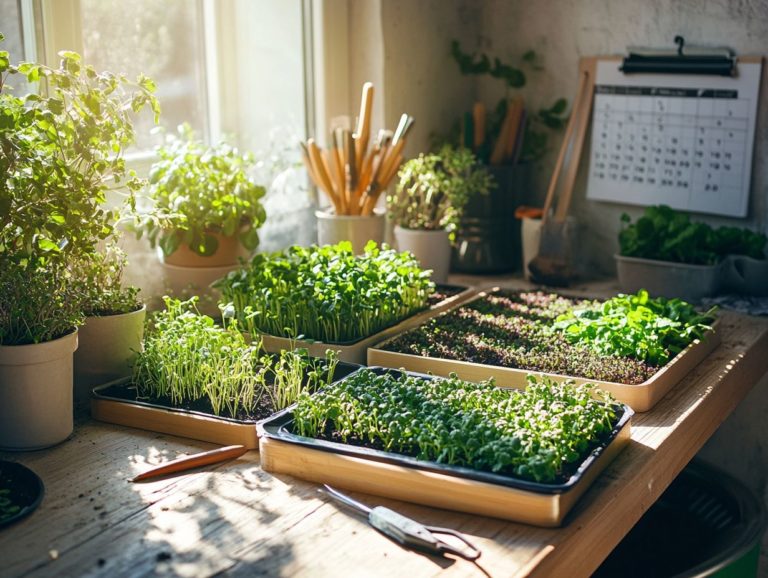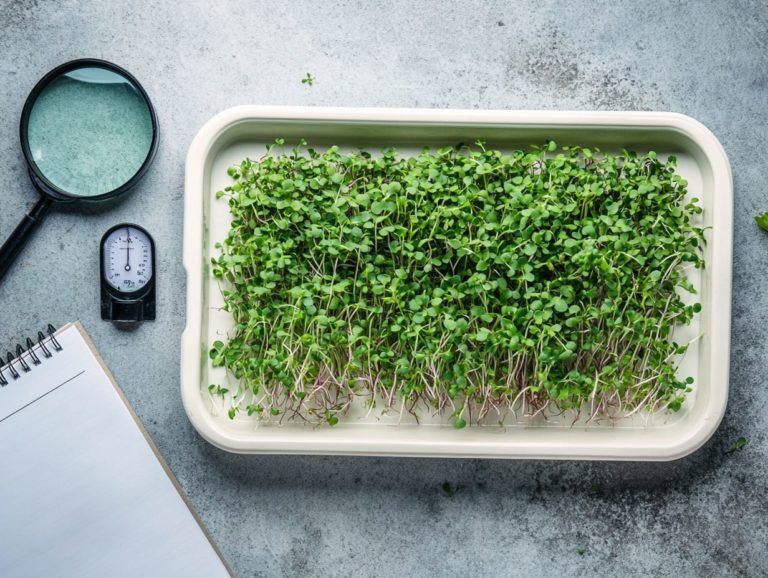How to Grow Microgreens in a Small Space
Microgreens are tiny, nutrient-packed plants brimming with flavor and health benefits. For those with limited space, growing microgreens offers an effortless way to infuse fresh greens into your diet.
This article delves into the myriad advantages of cultivating these miniature powerhouses. You ll find guidance on selecting the perfect growing environment, along with a detailed, step-by-step process for planting and maintaining your greens.
You will find tips for harvesting and utilizing microgreens to elevate your meals, all while steering clear of common pitfalls. Dive in and unlock the full potential of microgreens in your kitchen!
Contents
- Key Takeaways:
- Benefits of Growing Microgreens
- Choosing the Right Space for Growing Microgreens
- Supplies and Materials Needed for Growing Microgreens
- Step-by-Step Guide to Growing Microgreens
- Harvesting and Using Microgreens
- Common Mistakes to Avoid
- Frequently Asked Questions
- What are microgreens and why are they popular to grow in small spaces, especially indoors?
- What do I need to get started growing microgreens in a small space?
- Can I grow microgreens indoors without natural sunlight?
- How do I care for my microgreens while they are growing?
- How long does it take for microgreens to grow and be ready for harvest?
- Can I reuse the soil for multiple harvests of microgreens?
Key Takeaways:
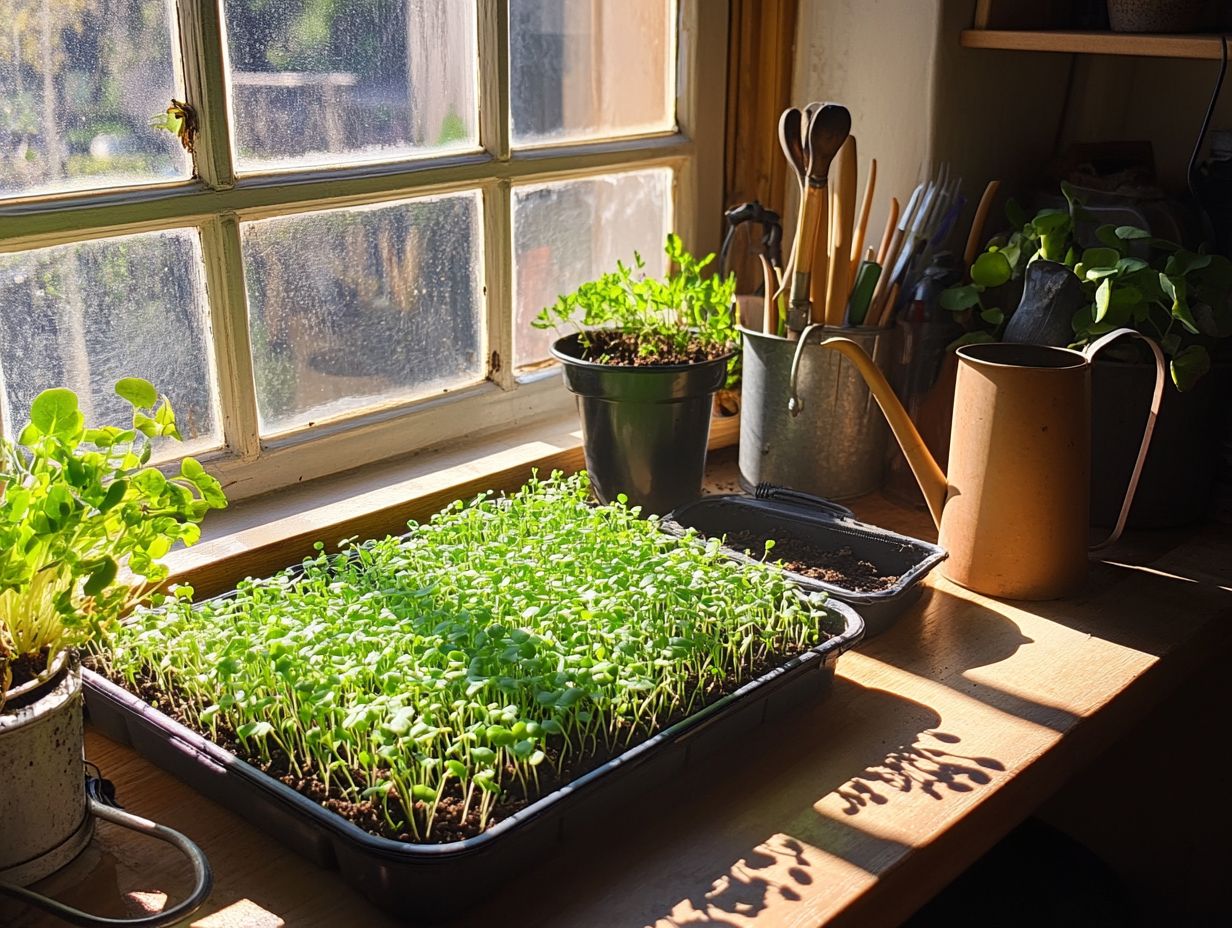
- Microgreens are small, nutrient-packed versions of plants that can easily be grown in a small space, making them a convenient and healthy addition to any diet.
- When choosing a space for growing microgreens, consider indoor options like a windowsill or outdoor options like a balcony or patio, depending on your access to natural light and weather conditions.
- To successfully grow microgreens, ensure you have the necessary supplies such as containers, soil, and seeds. Follow a step-by-step guide for preparation, planting, maintenance, and harvesting, while troubleshooting to avoid common mistakes.
What are Microgreens?
Microgreens are the young, edible plants you harvest right after the first true leaves make their appearance. These vibrant greens, from zesty broccoli sprouts to peppery arugula and radish, are brimming with flavor and nutritional perks, making them a go-to for health-conscious consumers and chefs alike.
They re easy to grow both indoors and outdoors, offering a quick and satisfying way to elevate the flavor and nutrient density of your meals. These greens contribute robust antioxidants, or substances that help protect your body, and health-promoting micronutrients to your diet.
Explore exciting options like basil, cilantro, and beets; these little powerhouses thrive in various growing conditions, needing just bright light and well-drained soil. The culinary possibilities are virtually endless; you can toss them into salads, blend them into smoothies, or use them as garnishes to elevate any dish to new heights.
Nutritionally, these tiny greens are impressive, often boasting higher concentrations of vitamins C, E, and K compared to their mature siblings. Regularly incorporating them into your diet is linked to myriad health benefits, including improved digestion, better heart health, and even enhanced skin vitality.
Don t miss out! Make microgreens a staple in your kitchen for a healthier, tastier diet!
Benefits of Growing Microgreens
Growing microgreens presents you with a wealth of health benefits, providing a robust supply of essential vitamins and antioxidants that make them a superb addition to your diet.
These petite greens are not only nutrient-dense; they also burst with flavor, enhancing your dishes while significantly improving your vegetable nutrition and overall well-being.
Nutritional Value and Convenience
Microgreens are truly a powerhouse of nutrition, offering a concentrated source of vitamins, minerals, and antioxidants. One such antioxidant, sulforaphane, is a compound found in certain plants that is believed to help fight cancer. Their convenience allows you to easily incorporate these greens into your everyday meals without sacrificing nutritional value.
When compared to their mature counterparts, microgreens often boast a higher concentration of beneficial compounds, making them a remarkable addition to your diet. For example, kale or broccoli microgreens can contain up to 40 times more nutrients than their fully grown versions.
With their rapid growth cycle, these little greens can be harvested within just two to three weeks, providing you with fresh produce right at your fingertips. Whether you sprinkle them atop salads, blend them into smoothies, or use them as a vibrant garnish, these small but mighty greens can elevate your dishes not only in flavor but also in health benefits, solidifying their status as an essential component of a balanced diet.
Choosing the Right Space for Growing Microgreens
Selecting the ideal space for cultivating microgreens is essential for thriving indoor gardening. Whether you decide on a dedicated indoor garden setup or prefer container gardening on a sunlit windowsill, making sure your plants get enough light is crucial.
This will not only foster healthy growth but also enhance the vibrant flavors of your microgreens.
Indoor vs. Outdoor Options

When weighing the options between indoor and outdoor methods for growing microgreens, consider factors such as light conditions and the types of growing mediums available. Indoor gardening gives you greater control over environmental factors, while outdoor gardening lets you harness the benefits of natural sunlight and fresh air.
In an indoor setup, you can utilize specialized grow lights to replicate the ideal light spectrum these delicate greens need. You can adjust these lights as your plants progress through their growth stages. On the other hand, outdoor gardening takes full advantage of abundant sunlight and natural air circulation, often resulting in quicker growth rates and richer flavors.
The choice of growing medium varies significantly as well. Indoors, you might opt for soil blends or hydroponic systems which grow plants in nutrient-rich water instead of soil providing a reliable foundation for your microgreens. Conversely, outdoor growers often plant directly in enriched soil or raised beds.
Each method brings its unique advantages and challenges that can greatly influence the quality of your harvest and the speed of growth.
Supplies and Materials Needed for Growing Microgreens
You ll love how easy it is to grow microgreens with the right supplies! A well-equipped microgreens kit should include a suitable growing medium think organic potting soil or a seed starting mix paired with high-quality sprouting seeds that enhance their beneficial properties.
Essential tools will streamline the germination process and improve your yield.
Essential Tools and Equipment
Essential tools and equipment for cultivating microgreens include:
- Containers
- A high-quality microgreens kit
- Adequate lighting systems that fulfill the light requirements essential for optimal growth
Daily watering of your microgreens plays a vital role in sustaining their health and vibrancy. Choosing the right containers is crucial for ensuring successful results; they must provide proper drainage to prevent root rot.
A microgreens kit typically comes with soil or a growing medium that delivers essential nutrients for robust growth. Lighting systems, particularly full-spectrum LED lights, mimic sunlight and are essential for photosynthesis, ensuring your microgreens flourish indoors. For those looking to enhance their growing techniques, understanding How to Use Hydroponics for Microgreens can provide even better results.
Along with these essentials, a spray bottle for watering can evenly distribute moisture without disturbing the delicate seedlings. Humidity domes maintain the necessary humidity levels during germination, making daily watering practices effective.
Collectively, these tools create an ideal environment for your microgreens, setting you up for success in your indoor gardening journey.
Step-by-Step Guide to Growing Microgreens
A step-by-step guide to growing microgreens encompasses several essential stages, beginning with the selection of an appropriate growing medium and extending to a thorough understanding of the germination process that is crucial for their success.
You ll also learn the art of daily watering to promote optimal growth. This meticulous approach guarantees that you can successfully cultivate and ultimately harvest microgreens that are not only flavorful but also packed with nutrients.
Ready to grow your microgreens? Let s dive in!
Preparation, Planting, and Maintenance
Preparation, planting, and maintenance are essential steps in your journey to successfully grow microgreens. It all begins with keeping the right moisture levels for seeds to sprout and selecting the right growing medium.
When choosing a suitable growing medium, options like soil or coco coir made from coconut husks provide necessary nutrients and excellent drainage.
During planting, evenly distribute the seeds across the surface and gently press them into the medium to enhance seed-to-soil contact.
After planting, maintaining moisture is critical; a fine mist works wonders without over-saturating the medium. Microgreens thrive under bright, indirect light and usually need around 12-16 hours of light daily.
By regularly checking soil moisture and adjusting light exposure, you can cultivate robust microgreens that not only thrive but also deliver vibrant flavors. For those interested in getting started, a step-by-step guide to sowing microgreens can be incredibly helpful, making them a favorite in culinary applications.
Harvesting and Using Microgreens
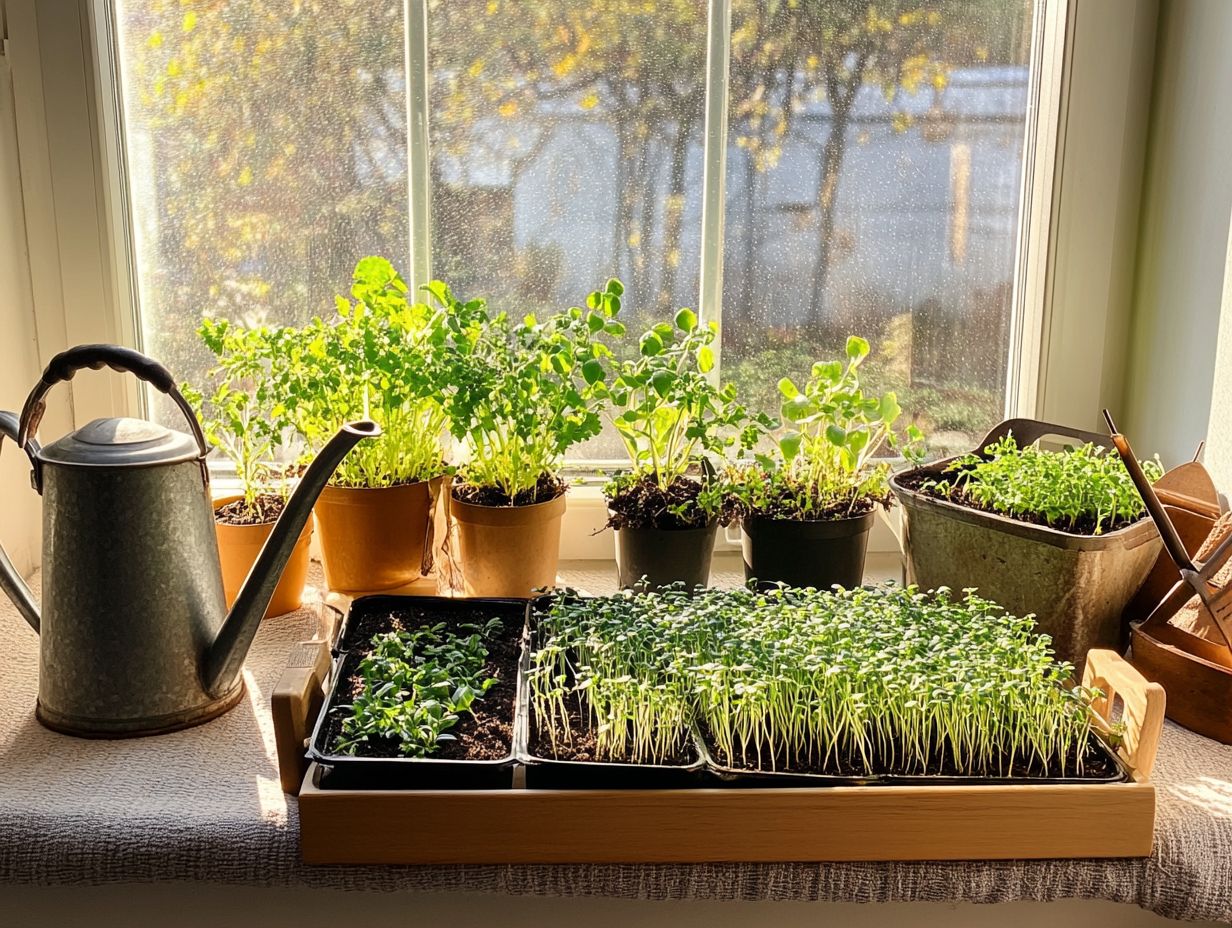
Harvesting microgreens is exciting! You’ll love the vibrant flavors and health benefits they bring to your meals.
Understanding the precise timing and technique for harvesting microgreens can significantly enhance the flavor profile of your culinary creations while maximizing their nutritional value.
Tips for Harvesting and Incorporating Microgreens into Meals
When you re ready to harvest microgreens, aim to do so just before they reach maturity. This ensures you capture their maximum flavor and health benefits.
Incorporating these delightful greens into your meals is simple; toss them into salads, add them to Buddha Bowls, or use them as garnishes to elevate the flavor profile of any dish, like broccoli sprouts or arugula.
These tiny greens are not just cute; they pack a serious nutritional punch, brimming with vitamins, minerals, and antioxidants, including health-promoting micronutrients like sulforaphane, a beneficial compound found in some vegetables that may promote health.
To enhance their versatility, blend microgreens into your smoothies for a nutrient boost, or sprinkle them atop avocado toast for extra texture and taste.
Jump in and experiment with exciting varieties like radish, basil, arugula, or kale to infuse unique flavors into your culinary creations. Remember, their vibrant colors do more than please the eye they enhance the dining experience, enticing even the most reluctant eaters to savor a healthy plate filled with nutrient-dense options like broccoli and peas.
Common Mistakes to Avoid
Avoiding common mistakes is vital for success in microgreens cultivation, especially when growing indoors. These missteps can hinder growth and lead to lackluster yields.
By recognizing potential pitfalls and fixing problems, particularly regarding light conditions and the right growing medium, you can create an environment where your microgreens thrive and yield exceptional results.
Troubleshooting and Preventing Issues
Troubleshooting issues in microgreens cultivation requires understanding light and watering practices. Water daily and monitor conditions closely. Misaligned care can stifle plant vibrancy. Implement preventive measures to nurture healthy microgreens effortlessly.
Light intensity is crucial. If your plants don’t get enough light, they may become leggy, which means they grow tall and spindly instead of strong and healthy. Too much light, on the other hand, can scorch them. Use grow lights at a safe distance for the best results.
Overwatering is another frequent misstep. By diligently monitoring soil moisture levels, you can avoid damp conditions that invite mold to crash the party. Keeping temperatures consistent around 65-75 F fosters a balanced environment conducive to growth.
Address these issues quickly. Whether using a microgreens kit or traditional container gardening, you ll be on your way to robust plants and a bountiful harvest.
Frequently Asked Questions
What are microgreens and why are they popular to grow in small spaces, especially indoors?
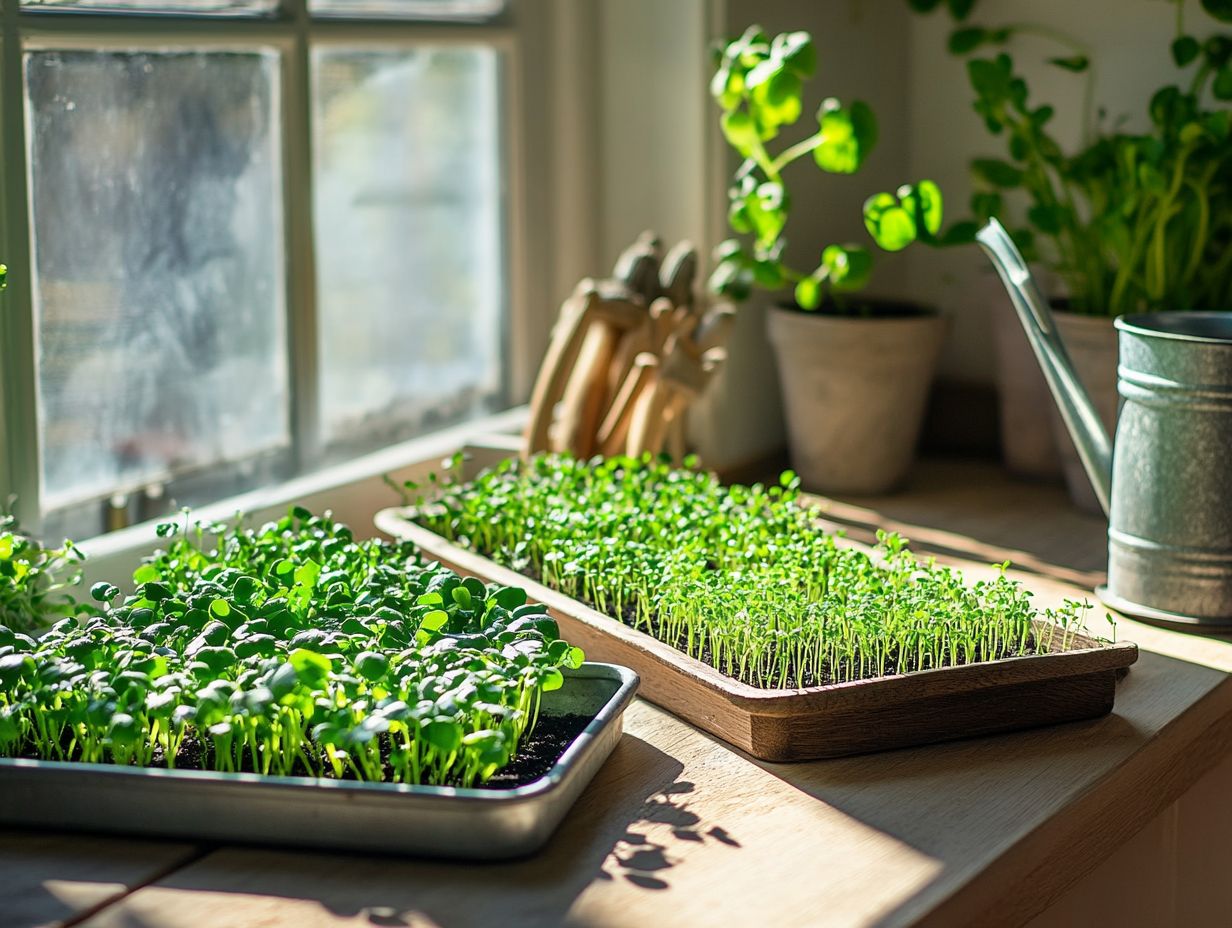
Microgreens are young, tender greens that are harvested at a very early stage of growth. They are packed with nutrients and offer significant health benefits, including high antioxidants, making them perfect for urban gardeners and those with limited space.
What do I need to get started growing microgreens in a small space?
All you need to grow microgreens in a small space is a glass container, organic potting soil, sprouting seeds, and a grow light. You can also use a grow kit specifically designed for microgreens for added convenience.
Can I grow microgreens indoors without natural sunlight?
Yes, you can still grow microgreens indoors without natural sunlight. A grow light provides the necessary light for their growth, which is essential for the germination process and optimal growth.
How do I care for my microgreens while they are growing?
Microgreens are low maintenance and easy to care for. Simply water them daily and ensure they have enough light. It is also important not to overcrowd the seeds when planting to allow for proper air circulation and healthy growth.
How long does it take for microgreens to grow and be ready for harvest?
The time it takes for microgreens to grow and be ready for harvest varies depending on the type of greens, such as kale or buckwheat, but on average it takes 1-3 weeks. Keep an eye on their growth and harvest them when they reach a height of 1-3 inches.
Can I reuse the soil for multiple harvests of microgreens?
Yes, you can reuse the soil for multiple harvests of microgreens. However, it is important to replenish the nutrients in the soil by adding compost or fertilizer and using organic seeds. You can also rotate the crops to prevent soil depletion and maintain healthy growth.

